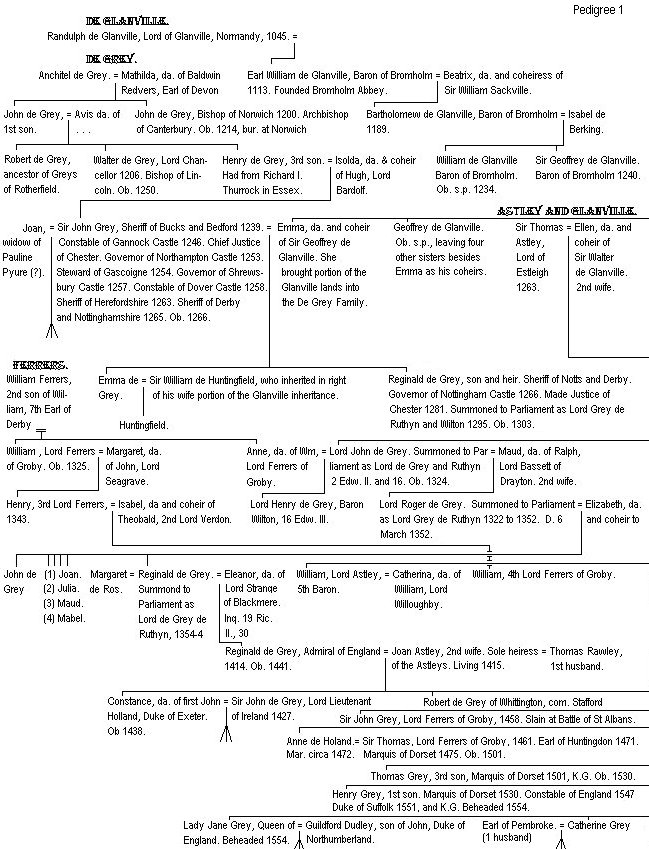
The Abbot then conveyed to him and his wife and their heirs the whole township, by the service and payment of 60s. per annum. Gilbert also acted as a Justiciary in several counties. In 1193, when Prince John, aided by Philip, King of France, attempted to seize the Crown, and endeavoured to prolong his brother's imprisonment by bribery, Hubert, Archbishop of Canterbury; Hugh, Bishop of Lincoln; Richard, Bishop of London; Gilbert Bishop of Rochester; Godfrey, Bishop of Winchester; with the Bishops of Worcester, Hereford, and Exeter pronounced sentence of excommunication in the chapel of the sick monks, Westminster, against him, and all his abettors and advisers who had, or might disturb the peace of the King of England, and the Archbishops and Bishops then took the castles of Lancaster and Nottingham for King Richard. Directly Gilbert was made Bishop of Rochester, he became engaged in a contest with the monks of his church, and if they ever entertained a favourable opinion of their new prelate, it was of short continuance. This dispute between the head and its members was carried on with uncommon warmth and virulence, and with very little remission during the whole of Glanville's administration.
It seems that hardly any of the historians knew the origin of the quarrel, and Bishop Godwyn has professed ignorance of the cause; but some light may be thrown upon this hitherto obscure branch of the history of this church by attending to the active part Glanville bore in a scheme of policy, wisely planned about this period. The monks of Rochester assumed the title of Regulars, and it was no less evident that they were a turbulent race of men, and the most zealous advocates for, and strenuous supporters of, the various usurpations of the Popes upon the royal prerogative. The dreadful effects of their open endeavours, as well as secret contrivances, were felt with reluctance by Henry II., who, perceiving the impracticableness of suppressing at once the authors of them, consulted his prelates and Ranulph de Glanville on the proper method of gradually diminishing the exorbitant power they had obtained. Henry seems to have been especially solicitous that the Bishops should prescribe some remedy to obviate the pernicious consequences which he foresaw must ensue from the privilege he had unwarily granted to the monks of Canterbury. The advice given by the advisers of the King was to erect colleges near the cathedrals occupied by the Regulars, and to fill them with secular canons, who would most probably form a powerful barrier against the encroachments of the Popes. In pursuance of this plan, Baldwin made preparations for founding a college at Hackington, near Canterbury; but being opposed by the monks of his own church the - account of which opposition is given under Ranulph de Glanville - he never finished it. Bishop Glanville and Hugh, Bishop of Lichfield, were the persons chiefly employed by the Archbishop to reduce those turbulent monks to obedience to their spiritual governor, and to chastise them for thwarting his laudable designs; thus did Glanville become so obnoxious to this religious fraternity. Weever says that Glanville "tooke away from them, i.e., the monks, all the moveable goods, all the ornaments of their church, their writings and evidences, yea, and a greater part of their lands, possessions, and privileges. Wanting money to follow their sluits against him, they were forced to coyne the silver of Sainte Paulinus shryne into money." Archbishop Baldwin commanded Bishop Glanville to reinvest the Chamberlain of Christ Church, and, 1188, the monks of the same place sent to him for chrism. In 1189, Gilbert was sent by the King to Canterbury, in company with Lord Ranulph de Glanville, his brother, Hubert Walter, his cousin, and the Bishop of Ely, and on his return he informed King Ricliard that the treasury of the monks belonged to him, and further shewed his hostility to them at Westminster. About this time he gave to Archbishop Baldwin, Lambeth in exchange for other lands. In his interview with the Pope's legate he urged him to maintain the rights of the See of Canterbury in reference to the election of the Bishop of Worcester.
In 1190, Gilbert de Glanville received at his Palace the prior and monks of Worcester, and then asserted his right to consecrate the Bishop of Worcester as the Archbishop's Chaplain and deputy, and he claimed to occupy the seat of the prelate at the coming ceremony. After a time he waived his right, but in doing so he had it recorded, by the historian Gervase, that such claim had been asserted. In the Easter of 1191, Gilbert was entertained at St. Gregory's, Canterbury, and afterwards attended the meeting of the Bishops there, on which occasion he delivered a speech to the Pope's legate.
On the death of Baldwin, Archbishop of Canterbury, Bishop Glanville was present at the election of the new Archbishop, and King Richard, writing to his mother, Queen Eleanor, desired her to command Gilbert, with the Bishops of London, Winton, and Lincoln, to support the election of Hubert Walter to the episcopal chair. At the Council held in London, in 1193, Gilbert rebuked the Archbishop of York for having his cross borne erect, and he entered into a dispute with the Bishop of London relative to the precedence of his See and that of London, which, at the coronation of Richard 1. he upheld, for being chaplain to the Archbishop of Canterbury he took the higher place.
He again, in 1198, attended a chapter, held at Canterbury, at which he spoke. On the death-bed of Archbishop Hubert, his cousin, he was sent for, in company with Geoffrey, Prior of Canterbury, when the Archbishop caused his will to be written. In 1207, Gilbert fled into Scotland (according to Gervase). On the 24th June, 1219, Gilbert de Glanville, Bishop of Rochester, died, having ruled that See for twenty-nine years, and filled the office of chaplain to Thomas a Becket, Baldwin and Hubert, Archbishops of Canterbury, having been Dean and Archdeacon of Liseaux, in Normandy, a Baron of the Exchequer, a Justiciary in Kent and other counties, and afterwards made Lord Chief Justice of England.
On his death the hatred of the monks did not cease, for they would afford him no proper obsequies; but buried him "most obscurely, or rather basely, without either singing, ringing, or any other solemnitie, and furthermore abused him with such like rime doggerell."
"Glanvill Gilbertus nulla bonitate refertis
Hie jacet immitis & amator maxime litis;
Et quia sic litem dum vixit solet amare
Nunc ubi pax nulla est, est aptior inhabitare."
These monks forgot that their superior had founded and endowed an asylum for poor men, of which I give the following particulars - [fn 73]
In 1330, when Hamo de Hethe visited this hospital, he discovered that its revenues had been unjustly used by the master, upon which he made fresh rules for its government.
King Edward III. granted the hospital a charter, and confirmed all the previous gifts of Gilbert de Glanville, Bishop of Rochester. Bishop Glanville also rebuilt the Episcopal habitation, which had been burnt down by one of those dreadful fires that formerly ravaged the city of Rochester. Alexander de Glanville, probably brother to Bishop Gilbert, was for some time Prior of Rochester, who, on the 5th March 1252 departed this life suddenly, as it is recorded, of grief.
Sir Walter de Glanville succeeded to these lands on the death of his father. [fn 75] He then held in the vill of Felstede, 1 messuage, and 44 acres of arable land, 2 of pasture, 2 of meadow, and 2 of wood, of the King in capite, by the service of 2s. 6d. per annum, except 4 acres of arable land, which he held of the Abbey of Caen, by the service of 8d. per annum. He also held 40 acres of land by his serjeanty of carrying a seam of oats at his own charge to the King's horses, whilst the King remained between the bridges of Stratford-by-London and Colchester. This land was afterwards rented for 2s. 6d. per annum, payable into the Exchequer. In the charters of Henry de Moucuden (?), Suffolk, and Richard, son of Ralph Paston, of Paston, Walter de Glanville is one of the witnesses. Sir Walter de Glanville dying in 1329, left issue Geoffrey de Glanville; Margaret, who married Stephen Alistre; and Ellen, who became wife to Sir Thomas de Astley, Lord of Estleigh, of whose issue notice will be taken further on. Geoffrey succeeded his father

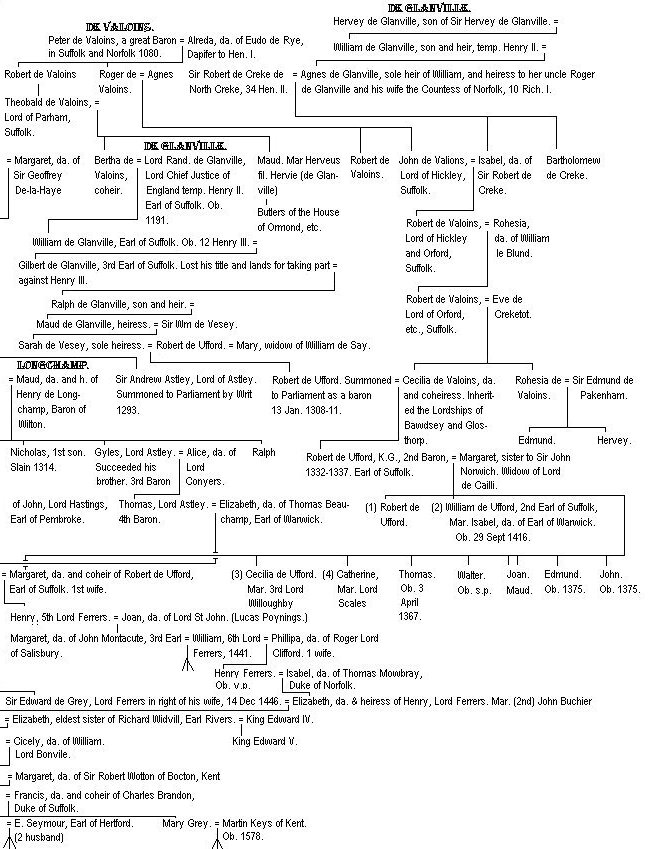
Ellen de Glanville, the daughter of Sir Walter, and wife of Sir Thomas Astley, Lord of Estleigh, [fn 77] had a son, Sir Andrew Astley, who succeeded his father, and was summoned to Parliament by writ in 1293. He left three sons, Nicholas, Lord Astley, slain 1314; Ralph Astley; and Gyles, who succeeded his brother Nicholas in the family estates. He married a daughter of Lord Conyers, and by her left a son, Thomas, Lord Astley, who married Elizabeth, daughter of Thomas Beauchamp, Earl of Warwick, and was succeeded by William, Lord Astley,. who espoused Catherine, daughter of William, Lord Willoughby; by this marriage he had issue a daughter, Joan, who became his heiress, and also representative of a branch of the house of Glanville.
Joan, the heiress of the Astleys, married first Thomas Raleigh, Esq., of
Farnborough, com. Warwick, by whom she had issue - William, died a minor
8 Henry V., and a daughter, Joan, married (1) to Gerald Braybroke, and (2) to Edward
Bromflete. Secondly she married Reginald, Lord Grey de Ruthyn (second wife), who had
issue by her -
2. John de Grey, of Barwell, co. Leicester.
3. Robert de Grey, of Envill, Stafford.
4. Eleanor de Grey, married W. Lucy of Charlecote, Esq.
1. Edward de Grey, the eldest son (who, as has been shewn, was descended from
Sir Geoffrey de Glanville through his paternal line, and from Sir Walter de Glanville on
his maternal side, married Elizabeth, only daughter and heiress of William, Lord Ferrars,
of Groby, by Isabel, second daughter and coheiress of Thomas Mowbray, Duke. of
Norfolk), was summoned to Parliament in 1446 as Lord Ferrars, of Groby, which barony,
and that of Astley, descended regularly to Henry Grey, third Marquis of Dorset, K.G.,
who was created Duke of Suffolk on 10th October, 1551, and became forfeited upon
the decapitation and attainder of his Grace in 1554. (See Pedigree 1.)
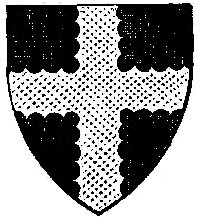
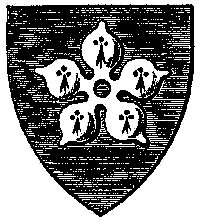
The first Hervey of the Glanville family was, in the year 1150, a very old man, [fn 82] as he himself informed the assembled Lords of Norfolk and Suffolk when they had met to consider the liberties that belonged to the Abbot of Bury {vide page 26), and in all natural probability he could not have been alive when Hervey de Glanville witnessed the foundation charter of Lord R. de Glanville to Butley in 1171, therefore "Herveus fil. Hervei," as Dodsworth says, was "Herveius de Glanvill frater Rogeri" (vide "Lib. De Acra," fo. 61). Roger de Glanville, we know, was brother to William de Glanville ("Lib. de Castle Acra," and Pipe 1 John, fo. 33b), and William was son of Sir Hervey de Glanville and brother to Hervey. [fn 83]
Hervey de Glanville (Herveus fil. Hervei) married Matilda, daughter of Lord Theobald de Valoins, Baron of Parham, Suffolk, whose other daughter, Bertha, married Lord R. de Glanville, the Chief Justiciary, that is, two brothers espoused two sisters. By this alliance Hervey de Glanville had issue, Theobald, who assumed the name of Le Botiller, and founded the House of Butler; Hamon, Herveus, and Hubert, afterwards Archbishop of Canterbury, and others.
Hervey de Glanville probably died while his children were young, for Hubert was brought up by his uncle, the Chief Justiciary, and on his ordination, was appointed his chaplain. Hubert, no doubt, rose to the high position he afterwards did through the interest of his celebrated relative De Glanville, and on his founding the Abbey of West Dereham, in 1188, he gracefully acknowledged the part Glanville had acted towards him. The following is portion of Hubert's charter:- "Omnibus sanctae matris ecclesiae. . . . . Hubertus D. G. Ebrocacensis ecclesiae decanus aeternam in domino Salutem . . . . . In honore Dei et gloriosae Virginis Mariae, matris ejus quoddam caenobium Praemonstratensis ordinis in feudo nostro apud Dereham fundavimus, pro salute animae meae, et patris et matris meae et domino Ranulphi de Glanvilla et dominae Berthae uxoris ejus, qui nos nutrierunt; et pro salute fratrum sororum, consanguineorum famularum (?) et omnium amicorum meorum, etc. Testibus, Dom. Johanne episcopo Norvicensi; Ranulpho de Glanvill; Waltero filio Roberti, Willielmo de Warenne, Galfrido fil. Petri, Radulpheo Archd. Colchestr', Magistro Bastholm', Ricardo persona de Derham, Osberto de Glanvill, Theobaldo Valoynes (Valoins), Theobald Walter . . . . et multis aliis." In the work entitled "The Normans in England," it is stated that Sir Hervey de Glanville's father was Walter de Glanville, brother to Robert, who held lands in Suffolk at the survey 1086, and both sons of Rainald or Ranulph de Glanville, of Glanville, in Normandy. "Hervey Walter, or de Glanville, had relinquished his Barony of Amounderness, which he held by the service of one knight's fee, to his son Theobald, before 1165, at which time, as Hervey de Glanville, he held one fee in Suffolk from the See of Ely. " [fn 84]
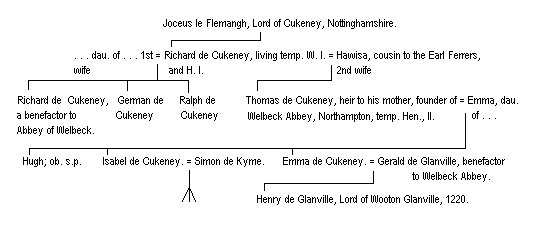
(1) Henry de Glanville, of whom presently.His second wife was Matilda, daughter and coheiress of Adam Fitz Swain, founder of Monk's Bretton Priory, Yorkshire. This Matilda married three times, the names of her other husbands being, Adam de Montebegon, Lord of Hornby, in Lancaster, and John de Maleherbe, who was dead in the 17th John.
(2) Bertha de Glanville, married to Lord William de Stuteville. [fn 85]
Lord de Stuteville, who married Bertha de Glanville, probably gave the Church of Dedham, in the Hundred of Lexden, Essex, to Butley Priory, founded by Lord Ranulph de Glanville, his wife's uncle. This gift continued to be held by the Prior of Butley until the dissolution. The Stutevilles were a great baronial house; they came in at the Conquest, and received large possessions in England. Robert de Stuteville fought against Henry I. at Tenerchebrai, and was taken prisoner. [fn 86] The family was officially connected with the Glanvilles in the North, and a close friendship appears to have existed between the two houses. One of them married a daughter of the De Valoins, which probably cemented still closer the families. William de Stuteville, of Gressenhall, Norfolk (a baron of the realm), espoused Margaret, daughter and heiress of Hugh de Say, of Richard's Castle, from whose descendants it passed by a female to the Talbots. The arms of Stuteville and Glanville are still to be seen at Richard's Castle. Bertha de Stuteville (nee Glanville) brought with her, on her marriage, the lordships of Braham and Leyburn. She had two sons, Robert, ob. s.p.; and Nicholas, who succeeded his brother (7th John). He married Gunnora, daughter of Hugh de Gurney, and relict of Robert de Gant, and by her had issue Nicholas de Stuteville, who died, 17th Henry III., leaving two daughters and coheiresses - Johanna, who married Hugh de Wake; and Margaret, the wife of William Mastoc. [fn 87] In the year 1207, Robert, son and heir of Ralph, Lord of Middleham, who married Helwisa de Glanville, daughter of Lord Ranulph de Glanville, the Chief Justiciary, gave 200 marks fine to the King for livery of the property belonging to Bertha, niece of Lord Banulph de Glanville, and wife of William de Stuteville, lying in Leyburn and Barham.
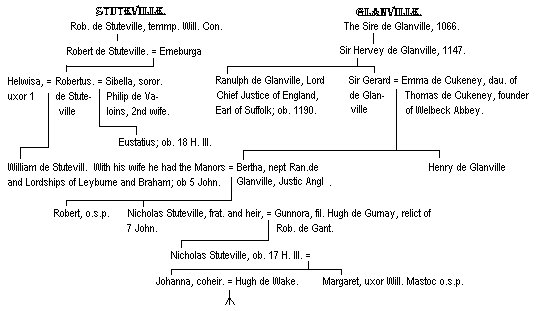
The lordship of Wooton-Glanville is situated in the county of Dorset, and bounded on the south by Buckland Newton; on the west by Middlemurst; on the north-west by Holwell; [fn 89] and on the east by Holwell. Close to the southern boundary of this place is an old Roman fortification called Dungeon. The parish contains, by estimation, nearly 1700 acres of rich land, and the population about 300.
In the custumary of Milton, under Knolle, Henry de Glanville held two virgates of land of the Abbot in Wolverne Wooton, paying yearly the sum of 18d. for all services. Tie also held lands in Somerset in 1213. De Glanville and his wife Philippa, [fn 90] with consent of his heirs, granted to Osbert de Bradleia and his heirs, for the said homage and service, his lands in Church Cnolla (Knolle), which Robert, the son of Osana, held of the fee of Witona. For this donation Osbert de Bradleia paid to Henry de Glanville, "in recognitionem," twenty shillings, to Philippa de Glanville his wife two shillings, to Galfrid de Glanville his son one shilling, and to John the son of Galfrid also one shilling. The witnesses to this deed were Henry de Stokes, Roger de Glanvill, Richard de Stokes, Robert de Clavill, Will' Cl'ico de Stupel, etc. Henry de Glanville married Philippa, daughter of Lord de Gant. The arms of this alliance are still to be seen at Richard's Castle. [fn 90]
The issue of this marriage was Geoffrey (Galfrid) de Glanville and Margaret de Glanville.
Geoffrey de Glanville, Lord of Wooton-Glanville, succeeded his father in this and other lands. Gilbert, the son of Osbert de Cnolla, granted to the Parson of Cnoll a moiety of one virgate of land, and common of pasture in the village of Church Cnoll (Knolle); and he paid yearly to Geoffrey de Glanville eighteenpence. For this donation the Parson (?) paid to Gilbert one mark, and to his two sisters half a load of wheat. The witnesses to this deed were Walter, persona de Corf, John de Smedemore, William de Clavil, Hugh de Chaldecote.
Bramston in Knole belonged to Galfrid de Estok, who granted it to John Estoke and Alice his wife, and their heirs, with homage and wards, etc.; the witnesses to this deed were Thomas de Ebblesborn, Abbot of Cerne, William de Lolleworth. By another grant, made in 1282, the same Galfrid de Estok quit-claims to John Estoke and his wife of these lands; Thomas, Abbot of Cerne, John de Mubeborn, Geoffrey de Glanville, and Henry de Pyddel being witnesses to the deed. In the reign of Edward I., Geoffrey de Glanville held lands in the manor of East Creech, Knole, which had been held by his father Henry de Glanville. Sir Geoffrey de Glanville married Alianore, and left issue Johanna de Glanville and John de Glanville, who, on the death of his father Geoffrey de Glanville, succeeded him in his estates.
Margaret de Glanville, the sister to Geoffrey, married William de Rede of Suffolk.

In the reign of King Edward III., William de Glanville held half a knight's fee in Knole, in Knotton; and also half a knight's fee in Church Cnolla, which he had inherited from Henry de Glanville. William married the Lady Sibyll, who in the year 1345 applied for, and received, licence from the King to build a chapel in addition to the church which then existed in the manor. Sibyll de Glanville, on her founding the Glanville Chapel, gave to it the manor of Foffardeston, which was in Sibyll's time a lordship, but now is extinguished and depopulated, and only the seat of the Browns of Frampton.
Peter de Dracot held in it, of the Glanvilles, half a knight's fee. In the time of Edward VI., this manor still belonged to the chantry of the Virgin Mary of Wooton-Glanville Church. There also seems to have existed another chapel in Foffardeston in 1550; but I have not been able to find anything concerning it. Besides the gift of the manor of Foffardeston, the Lady Sibyll de Glanville gave one messuage and lands in Wooton-Glanville. These donations were given to a chaplain to celebrate Divine Service every day for ever, before the altar of the Blessed Virgin in the parish church. On the death of her husband, and probably during the minority of her son John, she held other lands and tenements in the county of Dorset, of William de la Zouche, of Harringworth, by the service of one-eighth part of a knight's fee. She was also Lady of Wooton-Glanville, and besides held in Wooton-Wolvern a fourth part of a knight's fee which had formerly been held of Henry de Glanville in 1213. The Glanville Chapel has thus been described in a contemporary paper:-
"We come now to the Chantry, which is a truly ecclesiastical gem and a capital example of the Decorated period, probably in its most palmy time, if we may judge by the exquisite tracery and the flowing grace with which the windows have been executed. There is an effigy of De Glanville, Sybilla's husband, and she probably intended the other recess for her own statue. Under the arch lies the plain altar tomb, the effigy of Sybilla. The only painted glass which now remains is a neat figure of the Virgin Mary, and some other small fragments in the east window. On each side of this east window is a neatly carved bracket for relics or images. Above the site of the altar and in the south-east angle is an arched niche, containing a piscina and shelf. Under the arch, which separates this chapel from the body of the church, is a stone coffin with the effigy of a man in loose dress, belted, a sword by his left side, and a lion or dog (broken off) at his feet; length from head to foot when perfect about five feet ten inches; this is supposed to represent Sir Henry de Glanville. A small piece of the lid of the coffin has been broken off from the right side of the pillow, by which it appears that the coffin was a plain stone chest. In the north-east corner is a segment of an arch, which appears also to have opened into the chancel as well as the chantry; perhaps it contains the coffin of some of the founder's family. This chapel was formerly paved with figured tiles, intermixed with rows of small neat glazed tesserae; some fragments still remain, but much mutilated. Upon the largest of the square tiles is a shield with a very indistinct device, but apparently intended to be quarterly; I and 4, a tower triple turreted; 2 and 3, a lion rampant."
In the 1st Edward VI. the chapel was valued at £6 18s., and there was then one silver chalice of nine ounces, and John Mylle was incumbent. In the second year of the same King, Richard Randall was granted, inter alia, the chapel and also the capital messuage and lands belonging to it. [fn 93]
| Henry de Glanville, Lord of Wooton-Glanville. |
Presented to the Church as Rector, John Sprot, clerk, insd 4 cal. July, 1302. |
| Isabel Glanville, Lady of Wooton-Glanville |
Presented as Rector, 6 April, 1326, Galfrid de Wermondesworth. |
| Sibylla de Glanville. | Presented as Rector, II December, 1339, Robert de Mucheldener, clerk. |
| John Glanville, Lord of Wooton-Glanville |
Presented as Rector William Thornhull, on the cession of Mucheldener, who was presented to Winbourne St. Giles. |
| Patrons. | Chaplains. |
| Sibyll Glanville, foundress | Reginald de Souchan, pbr. insd Chaplain 5 March, 1344, of this chantry in the church of Wooton-Glanville, founded anew. |
| John Glanville, Lord of the Manor | Matthew Bremele, Chaplain, ins. 13 April,
1396. Thomas Wyneston, 1397. Henry Hew, inst. 28 Feb. 1397. |
| Robert More, in right of his wife Joan de Glanville. | Rich. Benet, 29 March, 1410. |
William and Sibylla de Glanville left a son, John de Glanville, Lord of Wooton-Glanville, who succeeded to the family estates on the death of his mother. During the year 1356 he and Peter Cubeworth (?) quit-claimed to John de Somerton, Ralph de Acton, son of John Demasale, etc., all their rights to the manor of Haselbury, Bream, Dorset, which they had by feoffment of John de Somerton. John de Glanville presented in 1396, 1397 (bis), a priest to the Glanville Chapel, and also one to the Parish Church, as lord and patron of Wooton-Glanville. Joan de Glanville, his daughter and heiress general, in the time of Henry IV. married Robert More of Marnhull and Manston, Esquire, and carried with her into that family the lordship of Glanville's Wooton and other lands. She had issue a daughter Edith More, who married John Newburgh of East Lullworth, Esquire, 1423, and brought with her Glanville's Wooton, in which family it remained to the time of Richard III., when it was alienated from the Newburghs to the Leighs. Robert More died before his wife Joan, for, on the 15th April, 1422, she and her son-in-law John Newburgh testified that they accounted at Doncaster for oibus, mesis, custibus, expensis, for clothes furrura (?) and other necessaries, as well for the said Joan as for John Newburgh, jun., and Edith his wife, bought at London, and expenses concerning their espousals, made by the said Robert More and John Newburgh, sen. Joan and John Newburgh, sen., to satisfy each other, except 70s. 10d. which Joan owed him by bond.
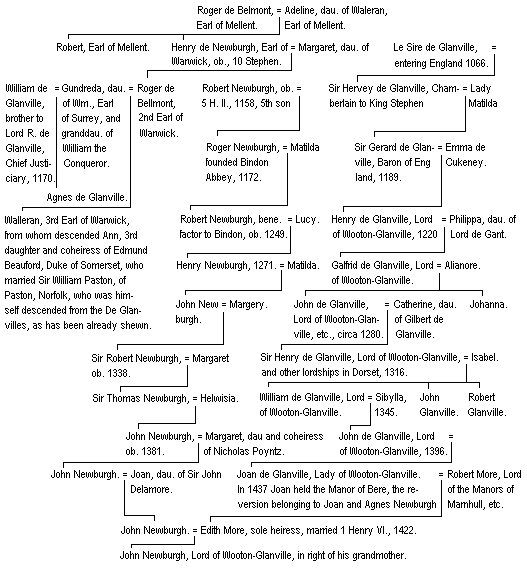
John Glanville [fn 95] settled at Halwell, [fn 96] in the parish of Whitechurch, Devon, about 1380, where his descendants continued to the year 1805, when the Halwell property was sold. Possibly it was he who assumed the "three saltires" for his armorial bearings, instead of a chief indented, although keeping the same tinctures. He married Alice, daughter of Thomas le Wrey, of Wrey, Devon, Esquire, from whose second son, Walter le Wrey, descended the present baronet. Sir Bouchier Wrey. By this union John Glanville had issue:-
1. John Glanville, son and heir.
2. Robert Glanville, served in wars of Castile in 1365.
3. Agnes Glanville, married (1) John, son of Sir Andrew Sackville of Sussex, ob. 1370; (2) John Cobat; (3) John Neville. She died March, 1420.
4. George Glanville.
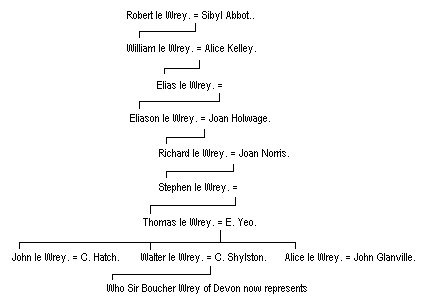
1. John Glanville, son and heir.John Glanville, son of John and Margaret, inherited Halwell on his father's death, and married Emma Courtney of "Neweton," Devon, [fn 98] and by her had issue, Nicholas Glanville of Halwell, living in the year 1495, and married Katherine, daughter of T. Preston of Devon, by whom he had:-
2. Nicholas Glanville.
1. Thomas Glanville, son and heir.Thomas Glanville, of Halwell, succeeded his father in the Halwell property, and he is mentioned in his brother John's will as "Thomas Glanville of Whitechurch." On the 5th May, 1568, Thomas married Dorothy Willye, and by her had issue:-
2. John Glanville, of whom further on.
3. Robert Glanville, Bailiff of the Priory of Launceston 1537.
1. Elizabeth, b. 10 Aug., 1572; buried 15 July 1630.
2. Dennis, b. 30 Jan., 1574.
3. Marjory, b. 4 Sep., 1575.
4. Jane, b. 2 Feb., 1578; m., John Drake, 26 Jan., 1596.
5. Pastis, b. 5 June, 1580.
6. Dorothy, 15 April, 1582.
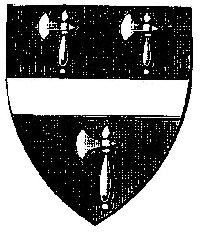
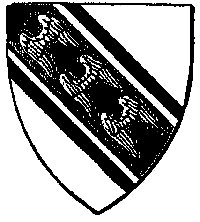
7. Agnes, b. 28 May, 1584; m Christopher Palmer, 9 June, 1607.Thomas Glanville, the son and heir, married Mistress Ursula Holls on the 24th July, 1604. The arms of Holls, as borne by the father of Ursula, and impaled by Thomas Glanville, were: Sa on a bend between a hound pass. in chief and a dolphin in base, ar., three torteaux. The issue of this union was:-
8. Thomas, b. 21 Feb., 1586.
9. Alice, b. 27 Aug., 1587.
10. Grace, b. 2 Jan., 1600; m., Hugh Hohame, 8 Aug., 1610.
1. Dorothy, m John Brownson, Nov. 27, 1628.John Glanville, the lineal descendant of Nicholas Glanville by Jane Bickford his wife (1635), sold Halwell House and property, as before stated, in the beginning of this century.
2. Francis, b. 16 Jan., 1615, whose wife's name was Susanna, and had by her several sons and daughters.
3. Nicholas, b. 15 April, 1611; m. 26 Jan., 1635, Mistress Jane Bickford, and had issue two sons and two daughters.
4. Thomas, "the younger," married Grace Brownson, 27 Nov., 1628, and had issue, Dorothy and John.
John [fn 99] Glanville of Tavistock was the younger son of Nicholas and Katherine Glanville of Halwell (revert to issue of Nicholas, page 74). As Halwell was in the possession of his elder brother Thomas, John settled at Tavistock, and by his will, which was proved the 1st February, 1580, he mentions his wife Thomazine, Mary Browne, Johanna Glubb, Alice Grylls, Agnes Hamlyn, his daughters; Thomas Glanville of Whitchurch, and John Glanville, his son; and the witness to it was the Rev. Robert Knight, Vicar of Tavistock, who probably married Mary Glanville his daughter. By his wife Thomazine he had issue:-
1. Johanna Glanville, married George Glubb, Esq., whose will was proved in London by Johanna, 9 June, 1591. From this alliance spring the Glubbs of Cornwall and Devon. [fn 100]
2. Agnes Glanville, married (1) Browne, and (2) Langford.
3. Mary Glanville, married (1) Bownd, (2) Littleton, (3) Knight.
4. Dennis Glanville, married William Grylls of Launceston, Esq., Oct. 21, 1578, and (2) Charles Glubb, Esq.
5. Mary Glanville, married John Skirrett, Esq., of Tavistock.
6. Alice Glanville, married (1) Hamlyn, (2) Grylls.
7. Raymond Glanville, fourth son.
8. Thomas Glanville of Tavistock, third son (see page 82).
9. John Glanville, Judge of Court of Common Pleas (for issue see further on).
10. Nicholas Glanville, eldest son and heir, married Elizabeth, daughter of William Ridley of Tavistock, Esq. Nicholas made his will 30 Aug., 1562, and it was proved 31 October, 1598. The following is a sketch of the document: "Nicholas Glanville, 80 Aug., 40 year of Queen Elizabeth;" he firstly gives to his daughter Johanna £500 lawful money of England on her "maryage," and "unto John the Sonne" of his daughter twenty pounds on his twenty-first birthday, Richard Gove twenty pounds, Leonard Gove twenty pounds, Nicholas Gove twenty pounds, Thomas Gove twenty pounds, and Mary Gove twenty pounds; the remainder he gives to his wife Elizabeth, and makes her sole executrix of his will. He also mentions his eldest son John Glanville, and his brothers Thomas Glanville and John Glanville (Judge of Common Pleas), whom he appoints overseer of his will. The witnesses to this document were "Thomam Mohun, Frauncis Birche, Robert Moore, Wyllyam Grills, Mathew Edgcumbe." Nicholas left issue by his wife Elizabeth:-1. Ralph Glanville, ob. s.p.
2. Rev. John Glanville (see page 81).
3. Nicholas Glanville, ob. s.p.
4. Tobias Glanville, ob. s.p.
5. Kedley Olanville, ob. s.p.
6. Richard Glanville, ob. s.p. [fn 101]
7. Agneta Glanville.
8. Johanna Glanville, married --- Gove, gent.
9. Eutatia Glanville.
10. Dewnes Glanville.
11. Tobias Glanville, who espoused Frances, daughter of George Wadham, Esq., and by her had issue, Nicholas Glanville, son and heir, bap. 16 Jan., 1597, at St. Stephen's-by-Saltash, and Elizabeth, baptized 1598. Nicholas left three sons: John Glanville, who lived at Plymouth; Benjamin Glanville, a merchant in London; and Joseph Glanville, who was born at Plymouth, 1630, and afterwards being educated at Oxford took the degree of M.A. in 1658. Having assumed the priestly office, he became Chaplain to Francis Rouse, who had been made Provost of Eton by Oliver Cromwell, but Rouse dying shortly afterwards, he returned to the University and pursued his studies to the period of the Restoration. On the re-establishment of the Church of England, Glanville was regularly ordained and became Rector of Wimbish in Essex, which living had been bought by his brother Benjamin, who conveyed it to him, 10 July, 1660. In November, 1662, he was presented to the living of Frome Selwood, by Sir James Thynne. In 1664 he was elected a Fellow of the Royal Society. He had previously written in defence of Experimental Philosophy against those who adhered to the doctrines of Aristotle and the Schoolmen, and his literary talents are said to have procured him many friends among the cultivators of Physical Science, through whose interest he obtained the Rectory of the Abbey Church of Bath, to which he was inducted 23 June, 1666; he then resided in that city, where he continued the remainder of his life. In 1672 he was made Chaplain in Ordinary to Charles II. His other preferments were a Prebend in Worcester Cathedral,
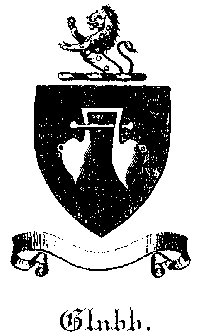
Joseph died at his house in Bath, Nov. 4, 1680, and was buried in the north aisle of the Abbey Church on the 9th. A monument to his memory was erected by his second wife Margaret, of the family of Selwins of Gloucester. His writings consist of three papers in the "Philosophical Transactions," a treatise on "Witches and Witchcraft, occasioned by the disturbance in the house of Mr. Mompesson, of Tidworth, in Wilts, which gave rise to Addison's 'Comedy of the Drummer, or the Haunted House;' " an essay concerning "Preaching Sermons;" and many controversial tracts. His chief literary opponents were the Rev. Robt. Crosse, Vicar of Chew Magna, and Dr. Henry Stubbs. By his first wife Ann, he left two children: (1) Joseph, bur. 5 July 1665; and (2) Maurice Glanville, M.A who was presented to the living of Wimbish, Essex, in 1680: he married Elizabeth, daughter of the Rev. Thomas Carter, D.D., Rector of Dibden, and left issue - (1) Elizabeth, 1711, married Rev. Thomas Bernard, M.A Rector of Wimbish, and had issue two sons, Thomas and Glanville, ob. s.p.; (2) Maurice; (3) Anne; and (4) Joseph, ob. 1690. On the death of Thomas Bernard in 1715, without issue, the living of Wimbish belonged to Ann Carter. Rev. Joseph. Glanville, by his second wife, left issue, Sophia, Henry, and Mary Glanville, who, with Margaret (nee Selwyn) his widow, and John Glanville of Plymouth, his brother, are mentioned in his will, proved the 8th October, 1680.procured for him. by the Marquess of Worcester, to whom. his wife was related, and the Rectory of Street near Glastonbury, for which he exchanged his Vicarge of Frome.
At the rebuilding of Wimbish Church some years ago, several stones were removed, and on one of them was the following:-
"Here was interred the body of Elizabeth, wife of Thomas Bernard, Rector of this Parish,
by whom she had issue two sons, Thomas and Ganville, both died, and were buried at Earls Coln,
Essex, within four months. She was only surviving child of Maurice Glanville, Rector of this
Church, and Elizabeth his wife, whose body lieth near under this stone, and granddaughter of
Joseph Glanville, adjacent, and Dr. Carter, late Rector of Dibden, Essex, aged 30.
Waiting a joyful resurrection."
It may be interesting to give the story Glanville wrote relating to the disturbance at Mr. Mompesson's house at Tedworth, to a portion of which Glanville himself was a witness. It appeared in March, 1660, Mr. Mompesson, J.P., had arrested a vagrant drummer, who had been an annoyance to the county, and had caused his drum to be taken from him and left in the bailiff's hands. This fact Mr. Mompesson imagined to be connected with the disturbances that followed, and of which the chief details are here given, quoted literally from Glanville's work:-
"About the middle of April following (that is, in 1661), when Mr. Mompesson was preparing
for a journey to London, the bailiff sent the drum to his house. When he was returned from that
journey his wife told him that they had been much affrighted in the night by thieves, and that the
house had like to be broken up. And he had not been home above three when the same noise was
heard that had disturbed the family in his absence. Hereupon he got up and went about his
house with a brace of pistols in his hands. He opened the door where the great knocking was, and
then he heard the noise at another door, but could discover nothing, only he still heard a strange
noise and hollow sound. When he got back to bed the noise was a thumping and drumming on
the top of his house, which continued a good space, and then by degrees went off into the air.
After this, the noise of thumping and. drumming was very frequent, usually five nights together,
and then it would intermit three. It was on the outside of the house, which was most of it board.
It constantly came as they were going to sleep, whether early or late. After a month's disturbance
without, it came into the room where the drum lay, four or five nights in seven, within half
an hour after they were in bed, continuing almost two. The sign of it, just before it came, was a
hurlng in the air over the house, and at its going off the beating of a drum like that at the breaking
up of a guard. It continued in this room for the space of two months which time Mr. Mompesson
himself lay there to observe it."
During Mrs. Mompesson's confinement, and for three weeks afterwards, it intermissed,
but, "after this civil cessation," says Glanvil, "it returned, in a ruder manner than before, and followed
and vext the youngest children, beating their bedsteads with that violence that all present
expected when they would fall to pieces. In laying hands on them, one should feel no blows, but
might perceive them to shake exceedingly. For an hour together it would beat "Round-heads and
Cuckolds," the "Tatoo," and several other points of war, as well as any drummer. After this they
would hear a scratching under the children's bed, as if by something that had iron talons, follow
them from one room to another, and for a while haunted none particularly but them."
"The next portion of the recital is still more marvellous, and Glanvil states that the occur-
rences took place in the presence of a minister of the gospel, Mr. Cragg, and of many neighbours,
who had come to the house on a visit.
The minister went to prayers with them, kneeling at the children's bedside, where it was
then very troublesome and loud. During prayer time it withdrew into the cock-loft, but returned
as soon as prayers were done, and then, in sight of the company, the chairs walk about the room of
themselves, the children's shoes were hurled over their heads, and every loose thing moved about
the chamber. At the same time a bed-staff was thrown at the minister, but so favourably, that a
lock of wool could not have fallen more softly; and it was observed that it stopt just where it
lighted, without rolling or moving from the place."
"Mr. Mompesson perceiving that it so much persecuted the little children, he lodged them
at a neighbour's house, taking his eldest daughter, who was about ten years of age, into his own
chamber, where it had not been a month before. As soon as she was in bed, the disturbance began
there again, continuing three weeks, drumming and making other noises; and. it was observed that
it would exactly answer in drumming anything that was beaten or called for."
"It was noted that when the noise was loudest, and came with the most sudden and
surprising violence, no dog about the house would move, though the knocking was oft so
boisterous and rude that it hath been heard at a considerable distance in the fields, and
awakened the neighbours in the village, none of which lived very near this."
The disturbances continued throughout two years, some of them being recorded as having
taken place in the month of April, 1663. Mr. Mompesson and his friends ascribed them to the
malice of the drummer, in league with the Evil One. And in this they were confirmed by the
following incidents, occurring in the month of January, 1662. Those who have any experience
in similar communications of our day know well how little confidence ought to be placed in
such, when uncorroborated by other evidence, except as an indication of some occult intelligence.
"During the time of the knocking, when many were present, a gentleman of the company
said, "Satan, if the drummer set thee to work, give three knocks and no more;" which it did
very distinctly, and stopt. Then the gentleman knockt to see if it would answer him as it was
wont, but it did not. For further trial he bid it, for confirmation, if it were the drummer, to
give five knocks and no more that night, which it did, and left the house quiet all the night
after. This was done in the presence of Sir Thomas Chamberlain, of Oxford, and divers others."
So far the narrative, as derived by our author from Mr. Mompesson and others, but
Mr. Glanvil himself visited the scene of the disturbance in January, 1662, and gives us the
result of his personal observation as follows:- "About this time I went to the house on purpose
to inquire the truth of those passages, of which there was so loud a report. It has ceased
from its drumming and ruder noises before I came thither, but most of the more remarkable
circumstances before related were confirmed to me there, by several of the neighbours together,
who had been present at them. At this time it used to haunt the children, and that as soon as they
were laid. They went to bed that night, I was there, about eight of the clock, when a maid-servant,
coming down from them, told us it was come. The neighbours that were there, and two
ministers who had seen and heard divers times, went away; but Mr. Mompesson and I, and a
gentleman that came with me, went up. I heard a strange scratching as we went up the stairs, and
when we came into the room I perceived it was just behind the bolster of the children's bed, and
seemed to be against the tick. It was loud scratching, as one with long nails could make upon a
bolster. There were two little modest girls in the bed, between seven and eleven years old, as I
guess. I saw their hands out of the clothes, and they could not contribute to the noise that
was behind their heads. They had been used to it, and had still somebody or other in the
chamber with them, and therefore seemed not to be much affrighted. I, standing at the bed's
head, thrust my band behind the bolster, directing it to the place whence the noise seemed to come.
Whereupon the noise ceased there, and was heard in another part of the bed. But when I had
taken out my hand it returned, and was heard in the same place as before. I had been told that it
would imitate noises, and made trial by scratching several times upon the sheet, as five, and seven,
and ten, which it followed, and still stopped at my number. I searched under and behind the bed,
and turned up the clothes to the bed-cords, graspt the bolster, sounded the wall behind, and made
all the search that possibly I could, to find if there were any trick, contrivance, or common cause
of it; the like did my friend; but we could discover nothing. So that I was verily persuaded, and
am so still, that the noise was made by some demon or spirit. After it had scratched about half an
hour or more, it went into the midst of the bed, under the children, and there seemed to pant, like
a dog out of breath, very loudly. I put my hand upon the place, and felt the bed bearing
up against it, as if something within had thrust it up, I grasped the feathers to feel if any
living thing were in it. I looked under, and everywhere about, to see if there were any dog
or cat, or any such creature, in the room, and so we all did, but found nothing. The motion
it caused by this panting was so strong, that it shook the rooms and windows very sensibly.
It continued more than half an hour, while my friend and I staid in the room; and as long after,
as we were told.
"It will, I know, be said by some, that my friend and I were under some affright, and so
fancied noises and sights that were not. This is the eternal evasion. But if it be possible to know
how a man is affected when in fear, and when unconcerned, I certainly know, for mine own part, that
during the whole time of my being in the room, and in the house, I was under no more affrightment
than I am while I write this relation, and if I know that I am now awake, and that I see the objects
that are before me, I know that I heard and saw the particulars that I have told."
Mr. Glanvil concludes the relation:
To this fact Mr. Mompesson alludes in a letter written by him to a Mr, James Collins,
dated Tedworth, August 8, 1674, and published entire in Glanvil's book. I quote from that
letter:-
"The evidence upon oath were myself, Mr. William Maton, one Mr. Walter Dowse - all yet
living; and, I think, of as good repute as any this country has in it and one Mr. Joseph Cragg,
then minister of the place, but since dead. We all deposed several things that we conceived impossible
to be done by any natural agents, as the motion of chairs, stools, and bed-staves, nobody
being near them, the beating of drums in the air over the house in clear nights, and nothing visible,
the shaking of the floor and strongest parts of the house in still and calm nights, with several other
things of the like nature."
In another letter, addressed by Mr. Mompesson to Mr. Glanvil himself, under date
November 8,1672, he says:-
"Thus I have written the sum of Mr. Mompesson's disturbance, which I had partly from
his own mouth related before divers, who had been witnesses of all, and confirmed his relation; and
partly from his own letters, from which the order and series of things is taken. The same particulars
he writ also to Dr. Creed."
Meeting with Dr. Pierce accidentally, at Sir Robert Butson's he acquainted me of some-
thing that passed between my lord of R--- and yourself about my troubles, etc., to which (having
but little leisure) I do give you this account:- That I have been very often of late asked the question,
"Whether I have not confessed to his Majesty, or any other, a cheat discovered about that affair."
To which I gave, and shall to my dying day give, the same answer. That I must belie, and perjure
myself also, to acknowledge a cheat in a thing where I am sure there neither was or could be any,
as, I, the minister of the place, and two other honest gentlemen deposed at the assizes upon my
impleading the drummer. If the world would not believe it, it shall be indifferent to me, praying
God to keep me from the same, or the like affliction."
1667 Aug. 31. Mr. John Beale writing from Yeovil to Mr. Williamson, says that Rev Joseph Glanville finds himself environed with manifold dangers by the crowds of fanatics about Bath and Frome, etc., and that he has long applied for a remedy to his neighbour justices, but without success, and instead of affording protection, they have been offensive and exposed him to the rabble. The gentry, as well as the ignorant and ill-affected. help to beget the jealousy of Popery, and are apparently fallen back to 1642.
Joseph Glanville, writing from Bath, Sep. 10, 1667, to Dr. Beale, says that he is so troubled to see the uncontrolled madness and disorders of the people in these parts that he is almost weary at living. "They still grow in numbers and insolence, and openly denounce judgments, and pass damning sentences against all that come to the public. They say they shall have liberty of conscience, and that the government, which cannot stand longer, durst not do otherwise than permit them their freedom; they have arrived at such insolence," continues Glanville, "as to break open church-doors and to get into the churches to vent their sedition and rebellion perforce. The Minister of Marshfield, five miles off, is fain often to return from church for want of a congregation of two or three, when, at the same time, 500 are met in a barn in the town. They make up their barns into the formalities of churches, with seats for the convenience of speaking and hearing." He (Glanville) has taken all ways imaginable to keep his people within the bounds of sobriety and obedience, and preaches constantly twice a day to suit their humour in all things lawful, descending to the plainest speaking, and the most practical, and never uses a note, nor writes so much as a word. He treats those of the party with all civility and kindness, and is very pacificatory, both in public and private,
 Go to
Go toIndex to Book |
 Go to
Go toPrevious Page |
 Go to
Go toNext Page |
 Go to
Go toJay's Genes |